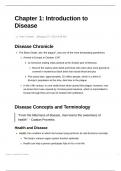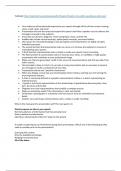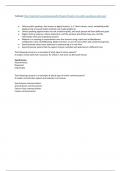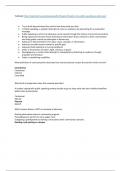University Of South Florida
Latest uploads at University Of South Florida. Looking for notes at University Of South Florida? We have lots of notes, study guides and study notes available for your school.
-
543
- 0
-
37
All courses for University Of South Florida
- ACCOUNTING 101 1
- ACCOUNTING 2021 2
- Accounting 2021 :Quick books online – 2020 Recertification Exam 1
- ACCOUNTING 2021QBO - Recertification 2020 ACCOUNTING 2021QBO - Recertification 2020 3
- ACCOUNTING 2021QBO - Recertification 2020. 2
- Anita Douglas Community Acquired Pneumonia Shadow Health 2
- Arun Patel Hypertension and Type 2 Diabetes Shadow Health- Transcript 3
- Assignment 10.2: Hypertension and Type 2 Diabetes Shadow Health; Arun Patel 2
- ATI Mental Health Week 1 SOP 4057 ATI Mental Health Week 1 1
- FInancial Analysis Graduate FIN 6406 1
- Focused Exam-Hypertension And Type 2 Diabetes Shadow Health-Prescription Writing 4
- Focused Exam-Hypertension and Type 2 Diabetes Shadow Health-Prescription Writing Focused Exam-Hypertension and Type 2 Diabetes Shadow Health-Prescription Writing Focused Exam-Hypertension and Type 2 D iabetes Shadow Health-Prescription Writing Show Less 1
- Focused Exam: Pediatric GAS Pharyngitis 1
- Focused Exam: Pediatric GAS Pharyngitis, Education and Empathy 1
- Focused Exam:Bipolar Disorder _ In Progress Attempt _ Shadow Health 1
- Focused Exam:Bipolar Disorder _ In Progress Attempt _ED Nursing Note Edit 1
- NUR 101 1
- NUR 2210C NUR2210C 1
- NUR 3081 2
- NUR 3125 NUR 3125 4
- NUR 3145 NUR 3145 10
- NUR 4467 NUR4467 7
- NUR 5304 SophiaHadad_MedicationSelection_ Pediatric GAS Pharyngitis _ Shadow Health 27
- NUR 5305 NUR5305 7
- NUR MISC NURMISC 5
- NUR5304 NUR5304 1
- NURS 5304 SOPHIA PATHWAY 3
- NURS MISC ATI RN 1
- NURSING 1
- Nutrition HUN2201 2
- SOP 4057 SOP4057 1
- Sophia Hadad Focused Exam Pediatric GAS Pharyngitis Results Education & Empathy Sophia Hadad Focused Exam Pediatric GAS Pharyngitis Results Education & Empathy 1
- SophiaHadad_MedicationSelection_ Pediatric GAS Pharyngitis _ Shadow Health|Medication Selection Score: 9 out of 9 points 2
- Survey of Criminal Justice 12
- Terrorism and Homeland Security 15
- TESTBANK FOR Understanding Pathophysiology, 5th Edition [GRADED A LATEST ] 1
- TESTBANK Huether and McCance: Understanding Pathophysiology, 5th Edition NUR 3125 1
- TinaJones Subjective Data Comprehensive Assessment Shadow Health. TinaJones Subjective Data Comprehensive Assessment Shadow Health. 1
Popular books University Of South Florida
Latest notes & summaries University Of South Florida
These are the notes I took for chapter 2: immunity and diseases for survey of human diseases. These notes contain the following topics: Immunity, nonspecific immunity, specific immunity, age and the immune system, diagnostic testing, and autoimmunity.
These are my notes to Ch.1 of Survey of Human Diseases (Introduction to Diseases). These notes contain the following information: Diseases concepts and terminology, diagnosis of diseases, the course of diseases, occurrence of disease, cause of diseases, risk factors, and so much more!!
This summary is from the textbook that is provided in the document. It explains reasons why presentation aids are important in public speeches, detailing how presentation aids function, and discuss strategies for implementing and integrating presentation aids.
This summary is from the textbook link given in the document. It talks about how to explore digital public speaking as an emerging medium. Define synchronous and asynchronous communication and strategize best practices for online speaking.
This is the summary of the textbook provided by the professor. This talks about how you define public speaking, it also outlines public speaking as a form of advocacy. Introduction to communication as constitutive, cultural. and contextual. Lastly, define communication apprehension and note strategies to manage anxiety before speaking.
Chapters 12 and 13 wrap up the Organic Chemistry 1 class. We begin Chapter 12 to learn about alcohols and phenols. Students should already have extensive knowledge about alkanes, alkenes and alkynes. They will then learn how the IUPAC name for alcohols differs slightly. They will also learn about oxidation and reduction reactions and how to recognize one. Additionally, students will learn about Grignard reagents and how they contribute to oxidation and reduction reactions. It is also important f...
Chapter 7 is a two week long chapter that introduces substitution and elimination reactions. Students will learn the reaction mechanisms for Sn1, Sn2, E1 and E2 reactions. They will also begin to understand the difference between protic and aprotic solvents, as well as what reagents are weak or strong nucleophiles and/or weak or strong bases. Understanding this concept will allow students to decide when a reaction will be an elimination and/or substitution reaction. These notes provide in-depth ...
Chapter 9 introduces alkynes. Students should already have prior knowledge about alkenes and will be pleased to know that the IUPAC naming system is similar. Students will learn how alkynes can be reduced into alkenes or alkanes. It is also important to take note of the different reagents and bases used to carry out these reactions. Students will also learn how carbon atoms can be added to or eliminated from a chain. Chapter 10 then introduces radical reactions which will be a very new concept t...
Hello! I'm currently a nursing student who passed with As and Bs in several required classes. I understand how hard it is to get help studying because I have been there before! In this set of notes, I cover the required course material for the immunity chapter of a pathophysiology course with some minor additional info to be more digestible in terms of memory and comprehension. The course revolves around the processes associated with disease or injury. Along with aside text, I also included inf...
Chapters 4, 5 and 6 introduce naming alkanes (single-bonded carbons) using the IUPAC system. Additionally, students learn how to distinguish between angle strain and torsional strain and how this concept relates to the amount of energy that a molecule holds. Learning about stereoisomerism is essentially to chapter 5 as this plays a role into how two similar (or different) molecules can be classified. Chapter 6 then introduces chemical reactivity and mechanisms of organic molecules. For example, ...











